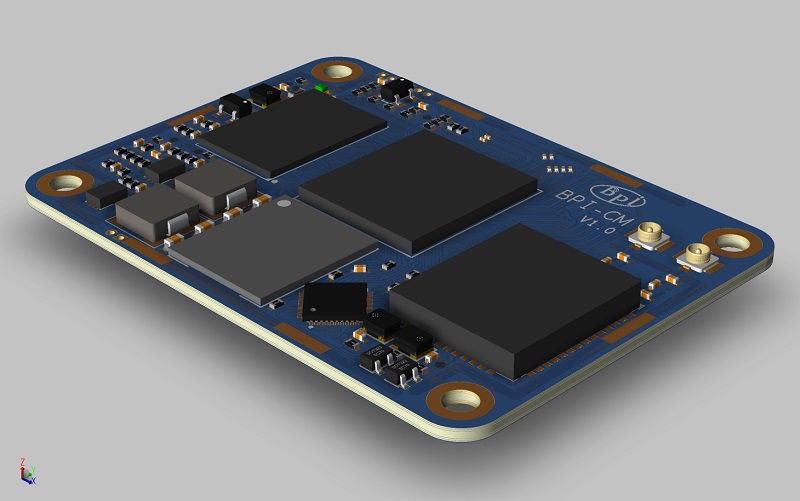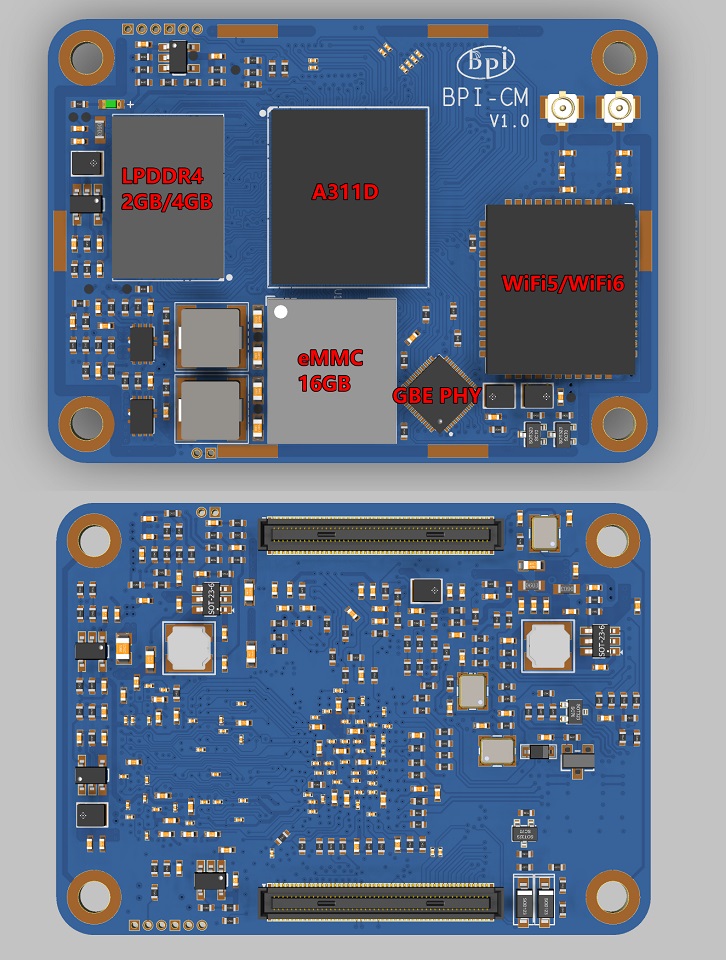Render Shows New Raspberry Pi Compute Module 4 Alternative From Banana Pi
Raspberry Pi alternative Banana Pi has released a render for an upcoming competitor to the Raspberry Pi Compute Module 4. The Banana Pi BPI-CM4 name gets straight to the point. This is a board designed to replace the Raspberry Pi Compute Module 4, and it seems that Banana Pi has squeezed plenty of power into the diminutive form factor.


The Banana Pi BPI-CM4 trades blows with Raspberry Pi’s Compute Module 4. In some areas, namely CPU and storage, it beats the Compute Module 4. But it can’t top the Raspberry Pi Compute Module 4’s RAM. The system on a chip (SoC) is an Amilogic A311D, which BananaPi also use on its BPI-M2S SBC. This SoC is elusive with its CPU speeds even nearly a year after its use with the BPI-M2S. However, we have an A311D2 SoC found in the Khadas VIM4 (a board we are in the process of reviewing). The Khadas VIM4 runs at 2.2 GHz (A73) and 2.0 GHz (A53). If these speeds apply to the Banana Pi BPI-CM4 (pinch of salt), then it will have quite the speed advantage over the Compute Module 4’s 1.5 GHz. Of course, you could overclock your board for a little more speed.
| Banana Pi BPI-CM4 | Raspberry Pi Compute Module 4 | |
| SoC | Quad core Arm Cortex-A73 and dual core Arm Cortex-A53 CPU | BCM2711 quad-core Cortex-A72 (Arm v8) 64-bit SoC @ 1.5GHz |
| GPU | Arm G52 MP4(6EE) GPU | Broadcom VideoCore VI |
| RAM | 2 / 4GB | 1 / 2 / 4 / 8GB |
| Storage | 16-128GB eMMC | 8-32GB eMMC |
| Display | 1 x 4K HDMI output (via carrier board) | 2 x 4K displays (via carrier board) |
| Wi-Fi | Wi-Fi 5 / 6 options | Wi-Fi 5 |
| Ethernet | Gigabit ethernet (via carrier board) | Gigabit ethernet (via carrier board) |
| PCIe | One interface expansion via carrier board | One interface expansion via carrier board |
The Raspberry Pi Compute Module 4 introduced a dual connector used to interface the board to a staggering range of carrier boards. These connectors break out everything we need — GPIO, PCIe, power, networking — to a convenient range of pins hidden under the board. Banana Pi has taken the same cue, and its board also features these same connectors, which means it should be physically compatible with carrier boards made for the Compute Module 4.
The Raspberry Pi is famous for its GPIO and looking at a pinout for the SoC we can see a bunch of GPIO pins dedicated to PCIe, HDMI, DSI, CSI and USB but nothing for general GPIO use. There will be some form of GPIO access, but right now we don’t know how it will be packaged.
Physical compatibility is not the be-all and end-all. To use the hardware, we need software, and the BPI CM4 may physically interface with Pi hardware; the same cannot be said for software. Raspberry Pi OS only runs on Raspberry Pi boards. The only exception is a version of the OS developed for older x86 devices. So what can we use with the BPI-CM4? It’s possible Banana Pi will reuse its existing Linux and Android images, or create new ones to take advantage of the hardware. Looking through the wiki for the older Banana Pi BPI-M5 we can see that there are official OS images for various Linux distributions such as Ubuntu, Debian and Raspbian (note that Raspbian is now very different to Raspberry Pi OS) and an Android release. Third-party images cover more Linux distros, mainly those developed to create appliances or to fulfill a certain task.
For now, all we have are the renders and the limited specifications, but Banana Pi’s latest board looks like an interesting drop-in alternative to the Compute Module 4.
Raspberry Pi alternative Banana Pi has released a render for an upcoming competitor to the Raspberry Pi Compute Module 4. The Banana Pi BPI-CM4 name gets straight to the point. This is a board designed to replace the Raspberry Pi Compute Module 4, and it seems that Banana Pi has squeezed plenty of power into the diminutive form factor.



The Banana Pi BPI-CM4 trades blows with Raspberry Pi’s Compute Module 4. In some areas, namely CPU and storage, it beats the Compute Module 4. But it can’t top the Raspberry Pi Compute Module 4’s RAM. The system on a chip (SoC) is an Amilogic A311D, which BananaPi also use on its BPI-M2S SBC. This SoC is elusive with its CPU speeds even nearly a year after its use with the BPI-M2S. However, we have an A311D2 SoC found in the Khadas VIM4 (a board we are in the process of reviewing). The Khadas VIM4 runs at 2.2 GHz (A73) and 2.0 GHz (A53). If these speeds apply to the Banana Pi BPI-CM4 (pinch of salt), then it will have quite the speed advantage over the Compute Module 4’s 1.5 GHz. Of course, you could overclock your board for a little more speed.
| Banana Pi BPI-CM4 | Raspberry Pi Compute Module 4 | |
| SoC | Quad core Arm Cortex-A73 and dual core Arm Cortex-A53 CPU | BCM2711 quad-core Cortex-A72 (Arm v8) 64-bit SoC @ 1.5GHz |
| GPU | Arm G52 MP4(6EE) GPU | Broadcom VideoCore VI |
| RAM | 2 / 4GB | 1 / 2 / 4 / 8GB |
| Storage | 16-128GB eMMC | 8-32GB eMMC |
| Display | 1 x 4K HDMI output (via carrier board) | 2 x 4K displays (via carrier board) |
| Wi-Fi | Wi-Fi 5 / 6 options | Wi-Fi 5 |
| Ethernet | Gigabit ethernet (via carrier board) | Gigabit ethernet (via carrier board) |
| PCIe | One interface expansion via carrier board | One interface expansion via carrier board |
The Raspberry Pi Compute Module 4 introduced a dual connector used to interface the board to a staggering range of carrier boards. These connectors break out everything we need — GPIO, PCIe, power, networking — to a convenient range of pins hidden under the board. Banana Pi has taken the same cue, and its board also features these same connectors, which means it should be physically compatible with carrier boards made for the Compute Module 4.
The Raspberry Pi is famous for its GPIO and looking at a pinout for the SoC we can see a bunch of GPIO pins dedicated to PCIe, HDMI, DSI, CSI and USB but nothing for general GPIO use. There will be some form of GPIO access, but right now we don’t know how it will be packaged.
Physical compatibility is not the be-all and end-all. To use the hardware, we need software, and the BPI CM4 may physically interface with Pi hardware; the same cannot be said for software. Raspberry Pi OS only runs on Raspberry Pi boards. The only exception is a version of the OS developed for older x86 devices. So what can we use with the BPI-CM4? It’s possible Banana Pi will reuse its existing Linux and Android images, or create new ones to take advantage of the hardware. Looking through the wiki for the older Banana Pi BPI-M5 we can see that there are official OS images for various Linux distributions such as Ubuntu, Debian and Raspbian (note that Raspbian is now very different to Raspberry Pi OS) and an Android release. Third-party images cover more Linux distros, mainly those developed to create appliances or to fulfill a certain task.
For now, all we have are the renders and the limited specifications, but Banana Pi’s latest board looks like an interesting drop-in alternative to the Compute Module 4.
